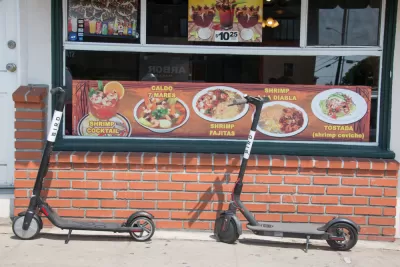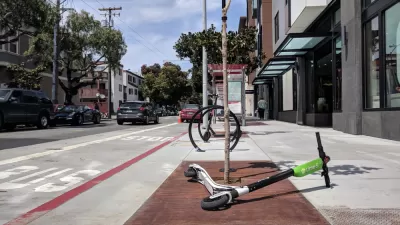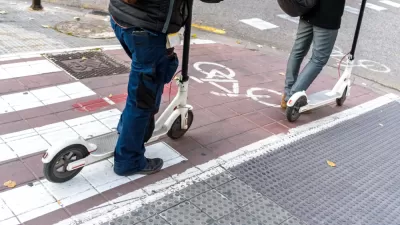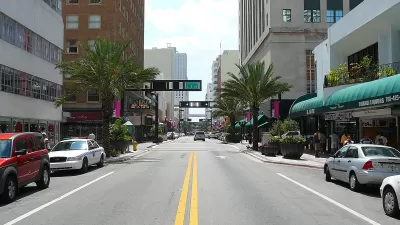A bill that would toss the helmet requirement for adult e- scooter riders and allow them to ride on roads where the speed limit is 35 mph, up from the current limit of 25 mph, is on Governor Jerry Brown's desk. He has until Sept. 30 to decide.

"Assembly Bill 2989 by Assemblyman Heath Flora, R-Ripon (San Joaquin County), passed the state Assembly 73-0 on Wednesday and now heads to Brown," reports Melody Gutierrez for the San Francisco Chronicle. "Brown has not weighed in on the bill."
The bill was sponsored in February by Manhattan Beach, Calif.-based Bird, valued at $2 billion in July, and the "the largest e-scooter rental company in California," reported Dara Kerr for CNET on July 16. In addition to doing away with the helmet requirement, as originally proposed, it would have:
- Eliminated the driver's license requirement for riders
- Raised the maximum speed to 20 mph
- Permitted scooters to ride on sidewalks
What the bill didn't do, as noted on an Aug. 17 blog on Systemic Failure, was lift the street speed limit restriction. The bill's text at that time read:
The operator of a motorized scooter shall not operate a motorized scooter on a highway with a speed limit in excess of 25 miles per hour unless the motorized scooter is operated within a Class II or Class IV bikeway.
The blog continues:
There are a lot of 30 mph streets where it is safe to operate a scooter, even where there are no bike facilities. While the bill does give cities the option to make exceptions to this rule, how likely is that given the reactionary policies we’ve seen from places like Santa Monica?
Well, someone from Flora's office may have read the blog, because here's the new text:
This bill would permit a local authority to authorize the operation of a motorized scooter on a highway with a speed limit of up to 35 miles per hour and would additionally allow for operation of a motorized scooter on a highway with a higher speed limit if the motorized scooter is operated within a Class IV bikeway.
Class IV is a relatively new category of bike lane defined by 2014 legislation, covered by Planetizen: "Legislation Supports Protected Bike Lanes in California." The exemption from the street speed limit restriction for streets with protected bike lanes, shows, in this correspondent's mind, the symbiosis between cycling and scootering.
As for the riding on sidewalks, Melanie Curry reported for Streetsblog California on June 13 that didn't sit well with pedestrian advocates.
“We were quite surprised that the bill included sidewalk riding, as well as an increase in speed to 20 mph. It was shocking to us,” said Cathy DeLuca of Walk San Francisco. “We are definitely strongly opposed to this change.”
Tony Bizjak, reporting for The Sacramento Bee on Aug. 29, made this observation on lifting the helmet requirement for riders 18 and older:
A Senate analysis of the proposed law noted that a study of 6,000 bike-related injuries found riders wearing helmets had a 52 percent lower risk of brain injury and a 44 percent lower risk of death. The analysis notes there is little information yet on the safety issues involved with motorized scooters.
Bizjak shares another example of bikes and scooters helping one another in noting that Bird and other scooter companies "have expressed interest in bringing their scooters to Sacramento."
The city, though, has a scooter and bike ordinance in place that would require scooter companies to install 1.5 scooter or bike racks for every scooter introduced in Sacramento, city transportation planner Jennifer Donlon Wyant said."
Finally, a word, or perhaps no words, on the mystery of the legislator who authored the bill, from CNET's Kerr.
Assemblyman Heath Flora, a Republican who represents part of the Central Valley, introduced AB-2989. No city in his district currently has rentable scooters.
Flora didn't return requests for comment.
More scooter stories accessible from Planetizen's Aug. 30 "Weekly Electric Scooter Media Brief."
FULL STORY: Adults on scooters could ride helmet-free under bill sent to Gov. Jerry Brown’s desk

Alabama: Trump Terminates Settlements for Black Communities Harmed By Raw Sewage
Trump deemed the landmark civil rights agreement “illegal DEI and environmental justice policy.”

Study: Maui’s Plan to Convert Vacation Rentals to Long-Term Housing Could Cause Nearly $1 Billion Economic Loss
The plan would reduce visitor accommodation by 25% resulting in 1,900 jobs lost.

Why Should We Subsidize Public Transportation?
Many public transit agencies face financial stress due to rising costs, declining fare revenue, and declining subsidies. Transit advocates must provide a strong business case for increasing public transit funding.

Paris Bike Boom Leads to Steep Drop in Air Pollution
The French city’s air quality has improved dramatically in the past 20 years, coinciding with a growth in cycling.

Why Housing Costs More to Build in California Than in Texas
Hard costs like labor and materials combined with ‘soft’ costs such as permitting make building in the San Francisco Bay Area almost three times as costly as in Texas cities.

San Diego County Sees a Rise in Urban Coyotes
San Diego County experiences a rise in urban coyotes, as sightings become prevalent throughout its urban neighbourhoods and surrounding areas.
Urban Design for Planners 1: Software Tools
This six-course series explores essential urban design concepts using open source software and equips planners with the tools they need to participate fully in the urban design process.
Planning for Universal Design
Learn the tools for implementing Universal Design in planning regulations.
Smith Gee Studio
Alamo Area Metropolitan Planning Organization
City of Santa Clarita
Institute for Housing and Urban Development Studies (IHS)
City of Grandview
Harvard GSD Executive Education
Toledo-Lucas County Plan Commissions
Salt Lake City
NYU Wagner Graduate School of Public Service





























